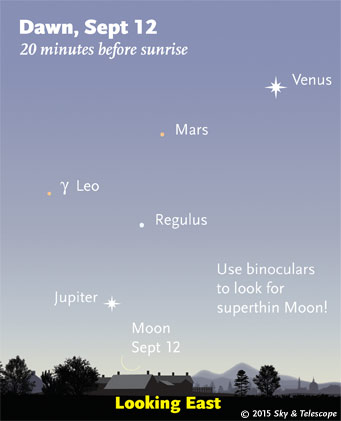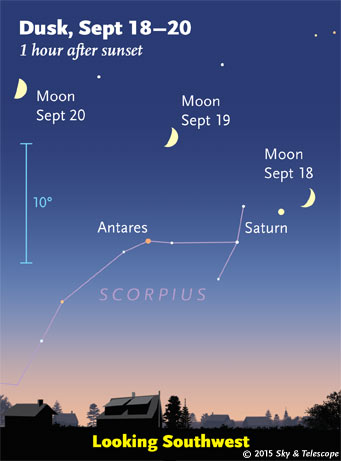Friday, September 11
• How soon after sunset can you identify the big Summer Triangle? Vega, its brightest star, is nearly straight overhead (for skywatchers at mid-northern latitudes). Deneb is the first bright star to Vega's east-northeast. Altair shines less high in the southeast.

• Thin-Moon challenge: Saturday's dawn offers a chance to try to set your record old-Moon sighting. Look just above the eastern horizon as dawn grows bright, as shown here. Bring binoculars or a telescope.
If you detect the Moon, note the time. Then see how close this is to the time of new Moon: 2:41 a.m. Sunday morning September 13th Eastern Daylight Time (6:41 September 13th UT).
Saturday, September 12
• The Great Square of Pegasus is high in the east after dark, balancing on one corner.
From the Great Square's left corner extends the big line of three stars, running to the lower left, that mark the head, backbone and leg of the constellation Andromeda. (The line of three includes the corner.)
Upper left from the end of this line, you'll find W-shaped Cassiopeia tilting up.
Sunday, September 13
• If you're in the Northern Hemisphere, this is a good time of year to spot the false dawn: the morning zodiacal light. Look east before true dawn begins, meaning at least 90 minutes before sunrise. The zodiacal light is an enormous, tall pyramid of smooth, gentle glow. It extends to the upper right along the zodiac through Mars and Venus to Gemini. What you're seeing is interplanetary dust in the plane of the ecliptic, lit by sunlight.
Don't confuse the zodiacal light with the Milky Way, more lumpy and irregular, to its right!
Monday, September 14
• Altair is the brightest star in the south after dark. Look for Gamma Aquilae (Tarazed) to its upper right by a finger-width at arm's length, and fainter Beta Aquilae a little farther on the opposite side of Altair. Delphinus, the Dolphin, is about a fist-width to Altair's left.
Tuesday, September 15
• As dusk turns to night, Arcturus twinkles due west. It's getting lower every week. Off to its right in the northwest, the Big Dipper is turning more and more level.
Wednesday, September 16
• Got light pollution? Cygnus overhead offers many sights for small telescopes regardless — if you can star-hop to them with a good finderscope. See Ken Hewitt-White's "Cygnus in the City" in the September Sky & Telescope, page 58, with chart and photos.
Thursday, September 17
• As twilight fades, look low in the southwest for the thin waxing crescent Moon off to the right of Saturn and Antares.

Friday, September 18
• As twilight fades, look low in the southwest for Saturn close to the waxing crescent Moon, as shown here. To their left are Antares and other stars of upper Scorpius.
Saturday, September 19
• The crescent Moon at dusk now forms a triangle with Antares below it and Saturn to their right.
__________________________
Want to become a better astronomer? Learn your way around the constellations. They're the key to locating everything fainter and deeper to hunt with binoculars or a telescope.
This is an outdoor nature hobby. For an easy-to-use constellation guide covering the whole evening sky, use the big monthly map in the center of each issue of Sky & Telescope, the essential guide to astronomy.

Once you get a telescope, to put it to good use you'll need a detailed, large-scale sky atlas (set of charts). The standards are the little Pocket Sky Atlas, which shows stars to magnitude 7.6; the larger and deeper Sky Atlas 2000.0 (stars to magnitude 8.5); and once you know your way around, the even larger Uranometria 2000.0 (stars to magnitude 9.75). And read how to use sky charts with a telescope.
You'll also want a good deep-sky guidebook, such as Sue French's Deep-Sky Wonders collection (which includes its own charts), Sky Atlas 2000.0 Companion by Strong and Sinnott, the bigger Night Sky Observer's Guide by Kepple and Sanner, or the beloved if dated Burnham's Celestial Handbook.
Can a computerized telescope replace charts? Not for beginners, I don't think, and not on mounts and tripods that are less than top-quality mechanically (meaning heavy and expensive). As Terence Dickinson and Alan Dyer say in their Backyard Astronomer's Guide, "A full appreciation of the universe cannot come without developing the skills to find things in the sky and understanding how the sky works. This knowledge comes only by spending time under the stars with star maps in hand."
This Week's Planet Roundup
Mercury has sunk away low in the sunset.
Venus (magnitude –4.8) is the brilliant "Morning Star" in the east before and during dawn. In a telescope it's a thickening crescent, shrinking in diameter as it pulls farther ahead of Earth around the Sun.
Mars, 400 times fainter at magnitude +1.8, glows 10° or 11° lower left of Venus in early dawn. Closer below Mars is Regulus, slightly brighter at magnitude +1.4.
Jupiter (magnitude –1.7) is even lower in the east during dawn. Look for it 9° below or lower left of Regulus.
Saturn (magnitude +0.6, in Libra) shines low in the southwest at dusk. Left of it by 12° twinkles orange Antares, slightly less bright.
Uranus (magnitude +5.7, in Pisces) and Neptune (magnitude +7.8, in Aquarius) are well up in the east and southeast, respectively, by about 11 p.m. Finder charts for Uranus and Neptune.
__________________________
All descriptions that relate to your horizon — including the words up, down, right, and left — are written for the world's mid-northern latitudes. Descriptions that also depend on longitude (mainly Moon positions) are for North America.
Eastern Daylight Time (EDT) is Universal Time (UT, UTC, or GMT) minus 4 hours.
__________________________
“This adventure is made possible by generations of searchers strictly adhering to a simple set of rules. Test ideas by experiments and observations. Build on those ideas that pass the test. Reject the ones that fail. Follow the evidence wherever it leads, and question everything. Accept these terms, and the cosmos is yours.”
— Neil deGrasse Tyson
 0
0
Comments
You must be logged in to post a comment.